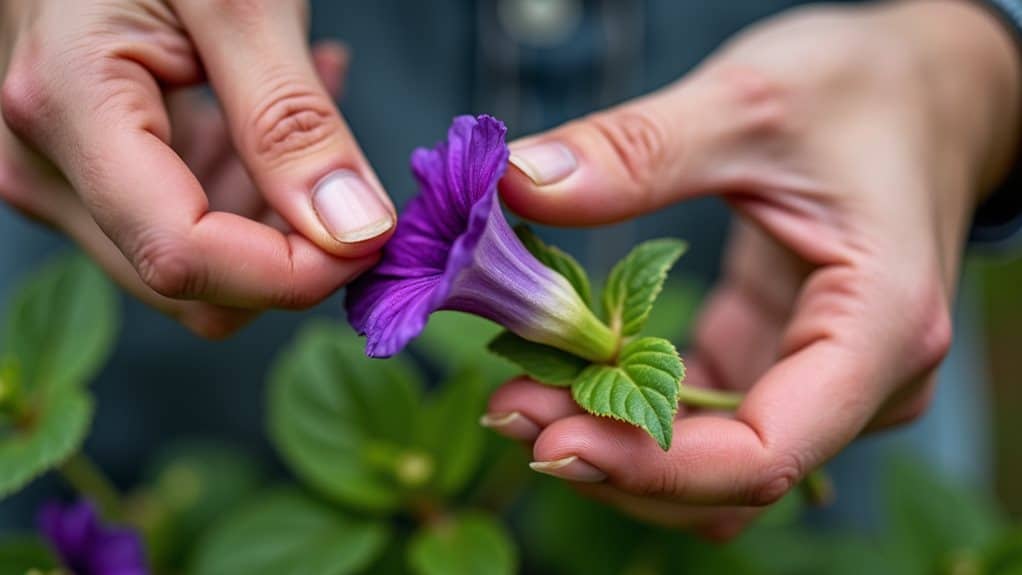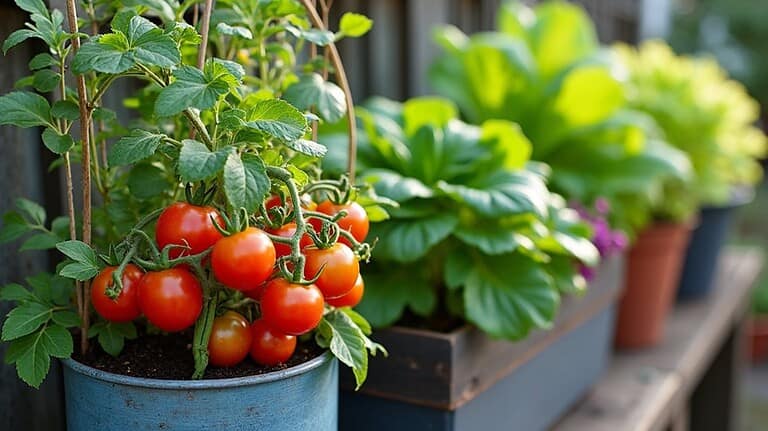Deadheading Basics for Continuous Blooms
Deadheading’s your secret weapon for turning any garden into a continuous bloom machine—simply snip off those faded, tired flowers about ¼ inch above healthy buds using clean bypass pruners or precision snippers. You’re basically tricking your plants into thinking they haven’t completed their mission yet, so they’ll keep pumping out gorgeous new blooms instead of going to seed. This game-changing technique works magic on everything from roses to marigolds, and once you hone the timing and plant-specific methods, you’ll uncover advanced strategies that’ll make your neighbors wonder how you’ve created such a spectacular flowering paradise.
Quick Guide
- Remove faded flowers by cutting ¼ inch above healthy buds to redirect plant energy from seed production to new bloom creation.
- Deadhead when 70% of blooms have faded, using bypass pruners for thick stems and precision snippers for delicate flowers.
- Regular deadheading throughout the growing season encourages continuous blooming and extends the overall flowering period significantly.
- Different plant types require specific deadheading approaches, with traditional bloomers needing more attention than self-cleaning varieties.
- Keep cutting tools sharp and clean to make precise cuts that promote plant health and prevent disease transmission.
What Is Deadheading and Why Does It Matter
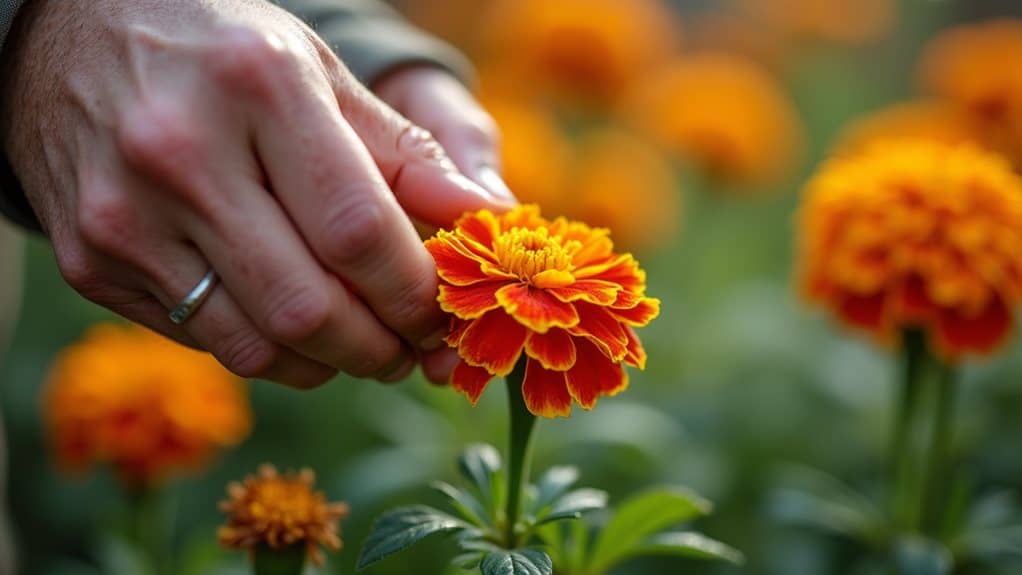
While you might think deadheading sounds like something from a scary movie, it’s actually one of the most rewarding and surprisingly addictive gardening techniques you’ll ever find!
Simply put, deadheading means snipping off those tired, faded flowers before they turn to seeds, tricking your plants into producing gorgeous blooms all season long. This technique works by redirecting energy that would normally go into seed production back into creating new blossoms instead. Additionally, by promoting continuous blooms, you are also enhancing the overall health of your garden, as well-draining soil is essential for maintaining vibrant plants.
Essential Techniques for Proper Deadheading
Now that you understand why deadheading’s such a revolutionary technique for your garden, let’s get our hands dirty with the actual methods that’ll make your plants bloom like they’re showing off at a county fair!
You’ll need to excel in three key skills: knowing exactly where to make your cuts (because one wrong snip can send your plant into a sulking fit), choosing the right tools for each job (trust me, using pruners on delicate petunias is like bringing a machete to a butter-spreading contest), and timing your deadheading sessions perfectly throughout the growing season. Regular inspections of your plants can also help you identify any pests that might hinder blooming.
Once you’ve got these fundamentals down pat, you’ll be deadheading like a pro gardener who’s been at this for decades, and your neighbors will wonder how you managed to turn your yard into such a blooming paradise! This simple technique works by redirecting energy from seed production to creating more beautiful flowers instead.
Proper Cutting Locations
Making the right cut in the right spot can mean the difference between a thriving garden that blooms all season long and one that looks tired and scraggly by midsummer – and trust me, I learned this lesson the hard way when I first started deadheading my mom’s prized petunias!
You’ll want to cut about ¼ inch above healthy buds or leaves.
Tool Selection Guidelines
Just like choosing the right tent for a camping trip can make or break your outdoor expedition, selecting the proper deadheading tools will determine whether your garden maintenance becomes a joy or a complete chore!
You’ll want bypass pruners for living stems, precision snippers for delicate flowers, and ergonomic handles that won’t cramp your hands during those marathon deadheading sessions.
Timing and Frequency
While you might think deadheading is as simple as snipping off a wilted flower whenever you notice one, excelling at the timing and frequency of this essential garden task requires the same strategic planning you’d use when deciding the perfect moment to set up camp before a storm rolls in!
Check weekly during growing season, deadhead when 70% of blooms fade.
Tools You Need for Effective Deadheading
You’ll want to grab the right cutting tools before you start your deadheading expedition, because trust me, trying to pinch off stubborn stems with your bare fingers is about as fun as setting up a tent in the rain!
Whether you’re working with delicate petunias or tough rose canes, having sharp, clean tools makes the difference between a satisfying gardening session and a frustrating battle with your plants. Just like you wouldn’t head out on a camping trip without checking your gear, you shouldn’t tackle deadheading without proper tool maintenance, since dull blades can actually harm your plants more than help them. Remember to keep pruning shears clean to prevent plant diseases and ensure healthy blooms.
Essential Cutting Tools
Success in deadheading depends heavily on having the right cutting tools in your gardening arsenal, and trust me, I’ve learned this lesson the hard way after trying to pinch off tough rose hips with my bare fingers – ouch!
You’ll need bypass pruners for clean cuts, garden scissors for delicate blooms, and maybe loppers for thicker stems.
Proper Tool Maintenance
Having the right tools won’t do you much good if they’re duller than a butter knife or rustier than an old ship anchor.
I learned this the hard way when my favorite bypass pruners completely mangled a beautiful dahlia bloom because I’d neglected them all winter!
Clean your tools immediately after use, oil them regularly, and store them hanging up.
Understanding Different Plant Types and Their Needs
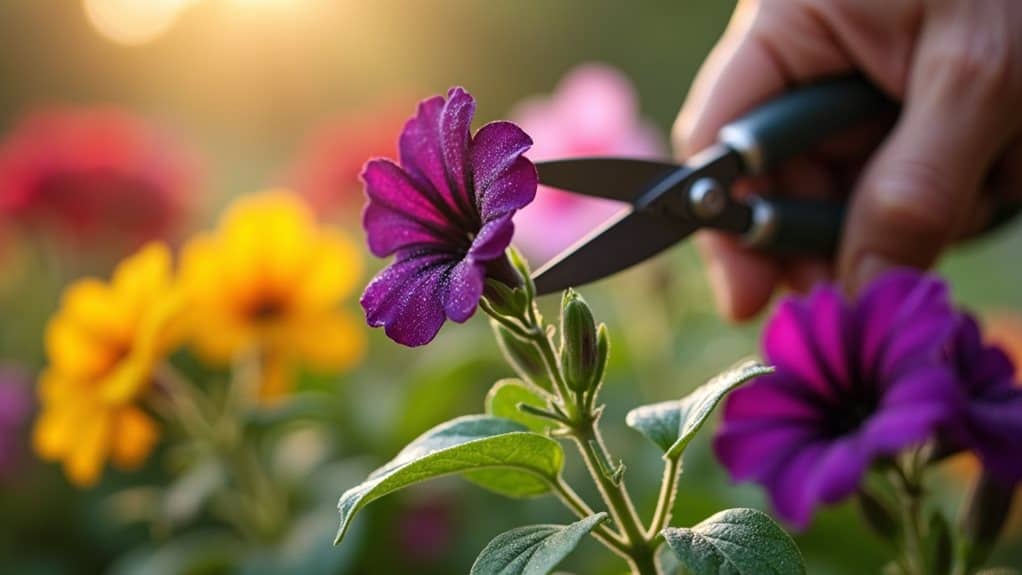
When you’re starting your deadheading expedition, it’s like learning the personalities of different campers around a campfire – each plant has its own quirks and preferences that’ll make or break your gardening success!
Traditional bloomers like peonies, roses, and dahlias absolutely love getting their spent flowers snipped off, while newer self-cleaning varieties practically maintain themselves!
Timing Your Deadheading for Maximum Results
Just like timing your arrival at the best camping spots before they’re all taken, excelling in the art of deadheading timing can change your garden from a one-hit wonder into a season-long spectacular show!
You’ll want to deadhead when about 70% of blooms have faded, cutting 1/4 inch above new buds to keep those flowers pumping out all season long.
How Often Should You Deadhead Your Plants
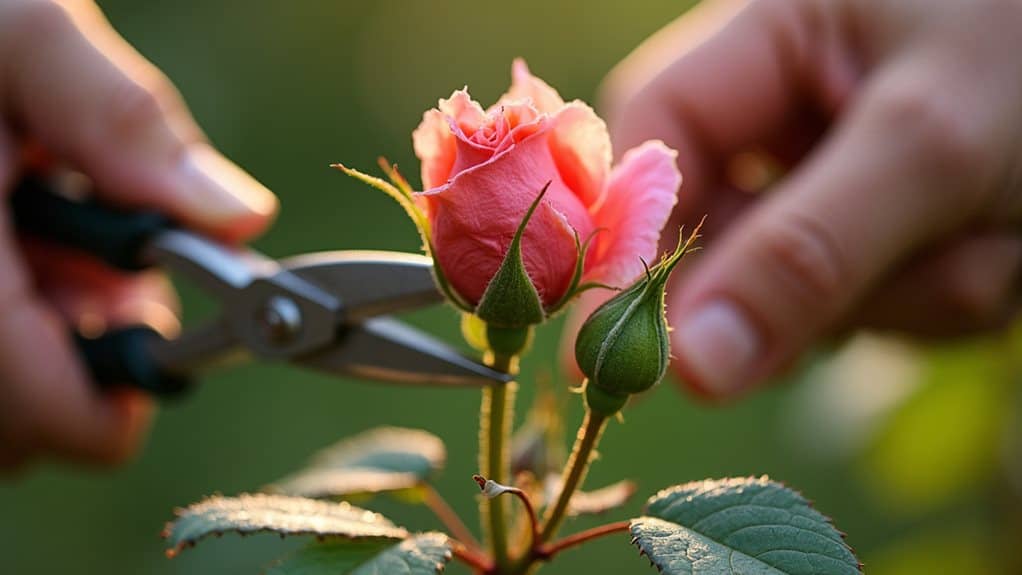
How often you’ll need to deadhead your plants depends entirely on what you’re growing and how quickly those blooms decide to call it quits, much like how some camping trips need daily cleanup while others can coast for days without attention!
Daylilies demand daily attention during peak season, while long-lasting blooms might only need weekly touch-ups.
Plant-Specific Deadheading Methods
While all plants need their spent blooms removed to keep looking their best, different types of stems call for completely different deadheading approaches, much like how you’d pack different gear for a rugged mountain camping trip versus a leisurely lakeside retreat!
Soft-stemmed beauties like echinacea practically beg for gentle finger pinching, while tough, woody roses demand sharp secateurs for clean cuts.
Benefits Beyond Beautiful Blooms
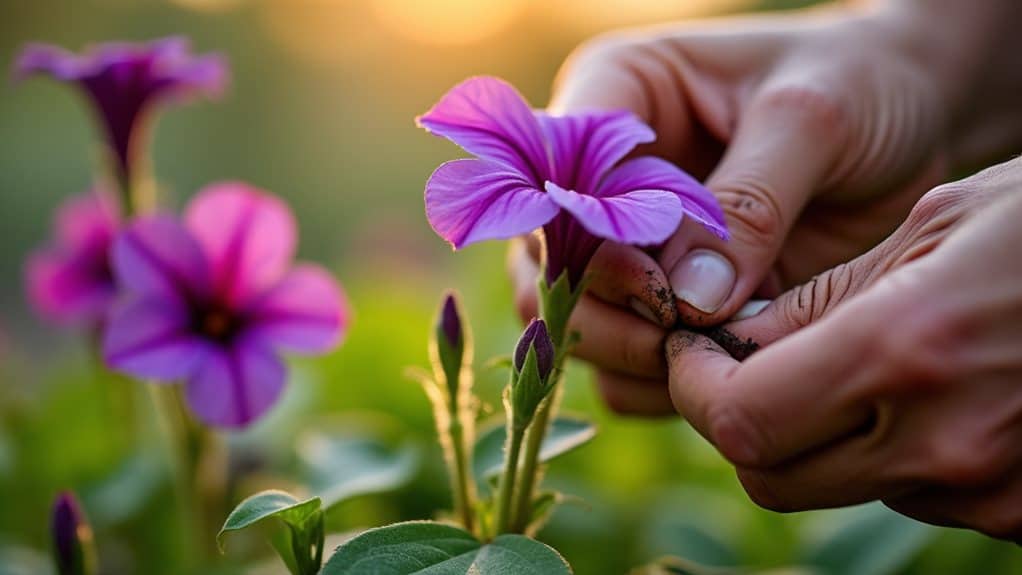
When you’re deadheading your flowers, you’re actually releasing a whole cascade of benefits that’ll make your garden absolutely flourish—kind of like how packing the right gear for a camping trip sets you up for an incredible expedition instead of a soggy disaster!
You’ll prevent diseases, control unwanted self-seeding, and keep your garden beds looking tidy.
Best Practices for Long-Term Success
Since mastering deadheading is like learning to properly maintain your camping gear—it’s all about developing consistent habits that’ll pay off season after season—you’ll want to focus on building a routine that becomes second nature and keeps your garden thriving year after year.
Combine deadheading with proper watering, fertilizing, and pest management while monitoring plant responses to avoid stressing them unnecessarily.
Wrapping Up
You’ve got all the tools and techniques now to keep your garden blooming like crazy all season long! Remember, deadheading isn’t just about making things look pretty – though that’s definitely a bonus – it’s about tricking your plants into thinking they need to keep producing flowers. So grab those pruners, get out there, and start snipping away those spent blooms, because your garden’s about to become the neighborhood showstopper you’ve always dreamed of!

